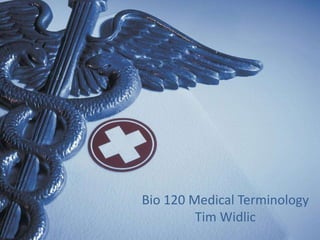
Bio 120 Endocrine System
- 1. Bio 120 Medical Terminology Tim Widlic
- 3. Hypercalcemia •Pertaining to an excessive amount of calcium in the blood. •Causes include: Excessive bone reabsorption and subsequent release of calcium; this occurs in hyperparathyroidism, metastatic tumors of the bone, Paget’s disease, osteoporosis, increased intestinal calcium absorption, or decreased renal calcium excretion. •Symptoms include: anorexia, abdominal pain, muscle pain, and weakness. •Signs include: confusion, cachexia, and hypercalciuria. Very high levels of blood calcium may result in coma, shock, kidney failure, and death. •Treatment includes administration of prednisone, diuretics, isotonic saline solution, and other drugs.
- 4. Hypercalcemia Pathology associated with hypercalcemia: •Hyperparathyroidism: A state whereby the parathyroid glands are releasing excessive amounts of PTH (parathyroid hormone), eventually resulting in an over activity in the osteoclasts. This process results in calcium being released into the blood, and in more severe forms, osteoporosis. •Metastatic tumors of bone: The osteolytic lesions/tumors that are present in metastatic cancer of the bone, results in hypercalcemia, as the bone matrix is broken down. • Paget’s disease: Overactive osteoclasts have a lytic effect on the bone, releasing calcium into the blood. The cells in the bone compensate for this by producing more bone, as well as an inordinate amount of fibrous connective tissue, in a chaotic manner, eventually resulting in a thicker, though weakened bone. •Osteoporosis: An abnormal condition of the bone, marked by excessive breakdown of the bone, resulting in “porous” bone. Leading to increased levels of blood calcium.
- 5. Polydipsia •Pertaining to excessive thirst. •Can result as a characteristic of several conditions, including : diabetes mellitus, diabetes insipidus, and nephrogenic diabetes insipidus. Can also occur as a result of blood loss and as a result of excessive alcohol consumption. Also can have a psychogenic origination. Pathology associated with polydipsia: •Diabetes mellitus: Manifests as a glucose imbalance in the blood, relative to the cells; this has the effect of osmotically pulling the intra-cellular fluid into the bloodstream and increasing the excretion of fluid via increased urination, which leads to reduced fluid volume, which in turn causes polydipsia. •Diabetes insipidus: A deficiency in the production and/or secretion of ADH (antidiuretic hormone, released by the anterior pituitary gland), results in excessive excretion of dilute urine, resulting in reduced fluid volume in the body, which in turn causes polydipsia. Severe dehydration and hypernatremia can result as a consequence.
- 6. Polydipsia Pathology associated with polydipsia, continued… • Nephrogenic diabetes insipidus: Due to an improper response of the kidney to normal levels of ADH (antidiuretic hormone), where the kidneys fail to concentrate the urine by removing free water. Other causes: •Hypovolemia: Blood loss, dehydration, emesis, excessive sweating, and severe burns can all contribute to a state of hypovolemia, an abnormally low circulating blood volume, thus increasing the likelihood of polydipsia. •Alcohol consumption: Alcohol has the effect of inhibiting ADH (anti-diuretic hormone). The inhibition of ADH has a diuretic effect, increasing water excretion by urination. Polyuria has the effect of causing polydipsia. •Psychogenic origination: In certain psychopathological conditions, such as schizophrenia, polydipsia manifests in the form of the obsessive drinking of water, regardless of thirst. Can result in depletion of electrolytes due to polyuria.
- 7. Polydipsia Treatment options: Diabetes mellitus: Can be managed with IV treatments of insulin (Type I), administration of oral medications (Type II), selective dietary intake, and exercise, so as to regulate blood glucose levels, keeping it within an acceptable homeostatic range. Diabetes insipidus: Can be managed with the administration of vasopressin (ADH) and/or thiazide diuretics. Nephrogenic diabetes insipidus: Can be managed with the administration of hydrochlorothiazide and amiloride. A low-salt and low-protein diet is considered. Hypovolemia: In cases of hypovolemia, the administrationo of IV fluids may be required.
- 8. http://en.wikipedia.org/wiki/Hypercalcemia http://en.wikipedia.org/wiki/Polydipsia http://en.wikipedia.org/wiki/Nephrogenic_diabetes_insipidus http://en.wikipedia.org/wiki/Hyperparathyroidism http://www.bonetumor.org/metastatic-tumors-bone-introduction http://en.wikipedia.org/wiki/Hypovolemia References: Fremgen, Bonnie F., Medical Terminology: A Living Language. 4 th. ed. Upper Saddle River: Pearson, 2009. Mosby's Medical, Nursing, and Allied Health Dictionary. 6th ed. St. Louis: Mosby, 2002. Internet sources:
- 9. Thank you for viewing.